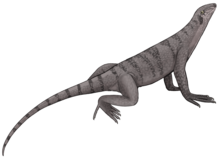Araeoscelis (from Greek: αραιά araiá, 'thin' and Greek: σκελίς skelís, 'ribs of beef')[1] is an extinct genus of tetrapods from the Early Permian of what is now Texas. Fossils have been found in the Nocona, Arroyo and Waggoner Ranch Formations. Two species have been described, A. casei and A. gracilis.[2]
| Araeoscelis Temporal range: Artinskian
| |
|---|---|

| |
| Life restoration | |
| Scientific classification | |
| Domain: | Eukaryota |
| Kingdom: | Animalia |
| Phylum: | Chordata |
| Class: | Reptilia |
| Order: | †Araeoscelidia |
| Family: | †Araeoscelidae |
| Genus: | †Araeoscelis Williston 1910 |
| Type species | |
| Araeoscelis gracilis Williston 1910
| |
| Species | |
| |
| Synonyms | |
| |
Araeoscelis belonged to the clade Araeoscelidia together with close relatives such as Petrolacosaurus. Araeoscelidia is often considered the most basal group of diapsid reptiles, but some analyses have recovered them as stem-amniotes instead.[3][4]
Description edit
Araeoscelis was around 60 centimetres (2.0 ft) long, and superficially resembled a modern lizard. It differed from other araeoscelidians, such as Petrolacosaurus, in that its teeth were larger and blunter; possibly they were used for cracking insect carapaces.[5]
Unlike Petrolacosaurus, which possessed the two pairs of skull openings characteristic of diapsids, in Araeoscelis the lower pair of temporal fenestrae were closed with bone, resulting in a euryapsid condition. This would have made the skull more solid, presumably allowing a more powerful bite.[5]
Ichnology edit
Footprints found in Nova Scotia have been attributed to Araeoscelis or a close relative.[2]
References edit
- ^ Colbert, Edwin H. (Edwin Harris); Knight, Charles Robert (1951). The dinosaur book : the ruling reptiles and their relatives. New York : Published for the American Museum of Natural History by McGraw-Hill. p. 145. Retrieved 17 December 2022.
- ^ a b Dixon, Dougal (2015). The Complete Illustrated Encyclopedia of Dinosaurs. London: Hermes House.
- ^ Simões, Tiago R.; Kammerer, Christian F.; Caldwell, Michael W.; Pierce, Stephanie E. (2022-08-19). "Successive climate crises in the deep past drove the early evolution and radiation of reptiles". Science Advances. 8 (33). doi:10.1126/sciadv.abq1898. ISSN 2375-2548. PMC 9390993. PMID 35984885.
- ^ Klembara, J.; Ruta, M.; Anderson, J.; Mayer, T.; Hain, M.; Valaška, D. (2023). "A review of Coelostegus prothales Carroll and Baird, 1972 from the Upper Carboniferous of the Czech Republic and the interrelationships of basal eureptiles". PLOS ONE. 18 (9): e0291687. doi:10.1371/journal.pone.0291687.
{{cite journal}}: CS1 maint: unflagged free DOI (link) - ^ a b Palmer, D., ed. (1999). The Marshall Illustrated Encyclopedia of Dinosaurs and Prehistoric Animals. London: Marshall Editions. p. 82. ISBN 1-84028-152-9.
Further reading edit
- Carroll, Robert L. (1988). Vertebrate Paleontology and Evolution. New York: W.H. Freeman and Co. ISBN 9780716718222.
- Benton, Michael J. (2000). Vertebrate Paleontology (2nd ed.). Oxford: Blackwell Science.
- Simon and Schuster (1999). The Simon & Schuster Encyclopedia of Dinosaurs and Prehistoric Creatures (1st ed.). Great Britain: Marshall Publishing. ISBN 0-684-86411-8.